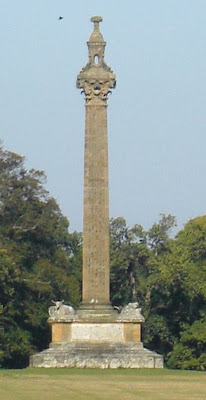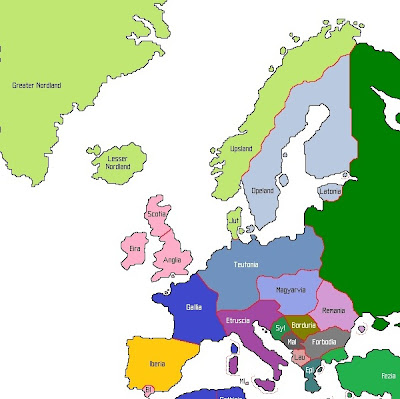My wife and I are currently in a state of limbo. Until the Coroner is happy with the cause of death, my father-in-law's body cannot be released ... and until that happens we cannot make any arrangements for the funeral, nor can we begin sorting out his finances and his estate. The post mortem should take place tomorrow, and assuming that the Coroner is satisfied with the results, we came begin making arrangements on Thursday. We have managed to sort out my father-in-law's 'filing system', and the documents are now neatly filed in date order in a number of properly labelled files that cover our dining table.
At present I have some spare time available to devote to wargame-related activity, and so far I have managed to finish revising my imagi-world map. The next thing I want to tackle is the background information that will go with the map, and with luck that should be finished later today or a some point tomorrow. After that I want to think about the number of wargame figures that I need to buy and paint so that I can begin using my imagi-world.
As I want my figures to be painted in the style of 'toy soldiers' (i.e. blocks of colour, no shading, and gloss varnished) I want to use figures that are fairly simple. In the old days my choice would have had to have been Peter Laing figures, but these are no longer available and I have to look for suitable substitutes. I suspect that I am going to end up using a mixture of Essex Miniatures, Irregular Miniatures, and Warrior Miniatures, but I am also considering Miniature Figurines figures as well. I have toyed with using larger scale figures than 15mm-scale (20mm, 28mm, 30mm, 42mm, and even 54mm-scale figures have all been given serious thought) but considerations of cost, convenience, and storage have influenced my thinking to date. That said, the Irregular Miniatures 42mm figures are exactly the right style for the sort of battles that I want to fight and I am finding them to be a very tempting alternative to 15mm.
At present I have some spare time available to devote to wargame-related activity, and so far I have managed to finish revising my imagi-world map. The next thing I want to tackle is the background information that will go with the map, and with luck that should be finished later today or a some point tomorrow. After that I want to think about the number of wargame figures that I need to buy and paint so that I can begin using my imagi-world.
As I want my figures to be painted in the style of 'toy soldiers' (i.e. blocks of colour, no shading, and gloss varnished) I want to use figures that are fairly simple. In the old days my choice would have had to have been Peter Laing figures, but these are no longer available and I have to look for suitable substitutes. I suspect that I am going to end up using a mixture of Essex Miniatures, Irregular Miniatures, and Warrior Miniatures, but I am also considering Miniature Figurines figures as well. I have toyed with using larger scale figures than 15mm-scale (20mm, 28mm, 30mm, 42mm, and even 54mm-scale figures have all been given serious thought) but considerations of cost, convenience, and storage have influenced my thinking to date. That said, the Irregular Miniatures 42mm figures are exactly the right style for the sort of battles that I want to fight and I am finding them to be a very tempting alternative to 15mm.







































































